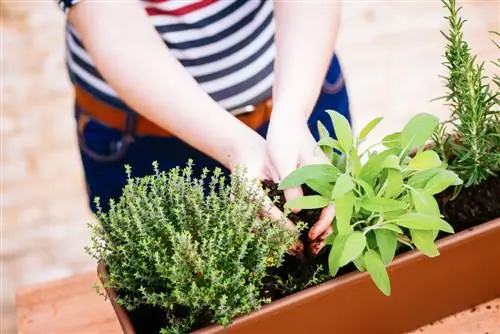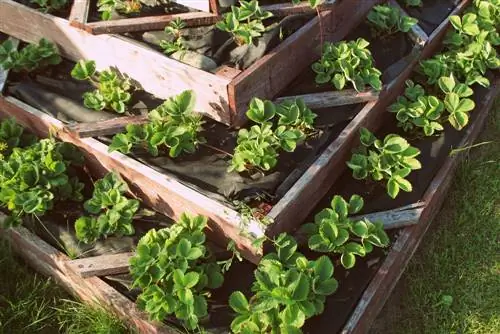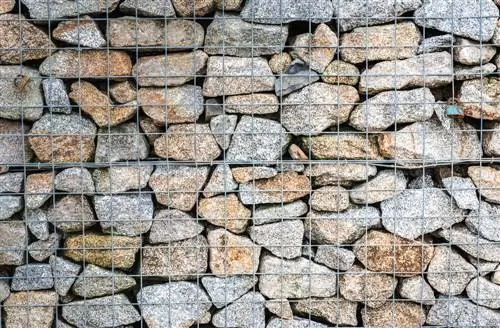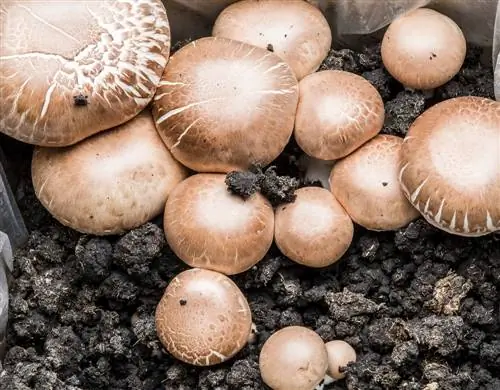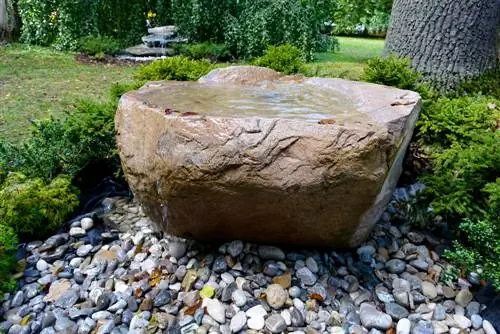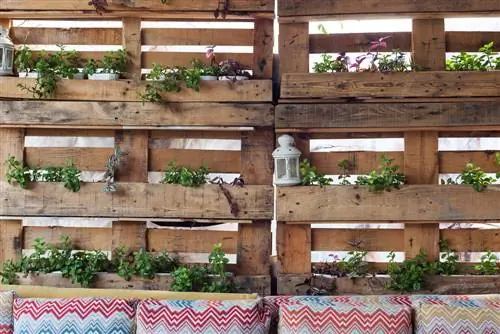- Author admin [email protected].
- Public 2023-12-16 16:46.
- Last modified 2025-06-01 06:02.
Step by step, the herb staircase acts as a decorative location for your favorite herbs. Hobby gardeners with skilled hands build this remarkable space miracle themselves. This guide comes with 2 tried and tested instructions for a wooden herb ladder and a stone model for the garden. Useful tips explain how to plant each floor correctly.

What is a herbal staircase?
A herb staircase is a decorative and space-saving way to grow different types of herbs. It can be made of wood, stone or metal and consists of several levels on which both local and Mediterranean herbs can thrive.
Build your own wooden herb staircase - DIY instructions
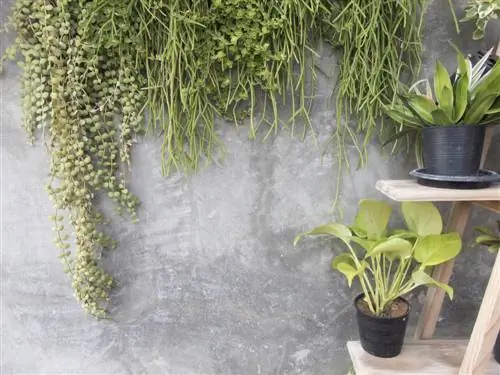
Building a wooden herb staircase requires some craftsmanship and precision
Do you have a herb staircase in mind for your balcony, terrace, winter garden or kitchen? You are well advised to use wood as a building material. The natural material is renewable, environmentally friendly, easy to work with and lightweight compared to stone. Do-it-yourselfers don't have to dig deep into their pockets to purchase one, as local wood can be bought inexpensively at any hardware store. The following instructions explain how to build a three-tier herb staircase yourself:
Material and tools
- Pine or spruce glued wood (ideally pressure impregnated)
- Cordless screwdriver
- Jigsaw
- Miter saw
- compass, pencil, clamps, gloves, safety glasses
- Screws M6, cap nuts M6, wood screws, wood glue, link chain (100 cm), wood stain (Blue Angel)
Instructions
The experts at the hardware store will cut the cut to the following dimensions using computer-controlled machines for a small fee:
| Number | Components | Dimensions in mm |
|---|---|---|
| 2 | Rear legs | 1140 x 60 |
| 2 | Legs at the front | 1200 x 60 |
| 1 | Rear cross brace | 672 x 60 |
| 3 | Support for boxes | 636 x 60 |
| 6 | Cross frames | 600 x 60 |
| 2 | Longitudinal frames of large box | 300 x 60 |
| 2 | Longitudinal frames of medium box | 250 x 60 |
| 2 | Longitudinal frames of small box | 200 x 60 |
| 1 | Bottom of large box | 564 x 264 |
| 1 | Bottom of middle box | 564 x 214 |
| 1 | Bottom of small box | 564 x 164 |
Precisely cut wood makes the following construction work a pleasure even for the inexperienced do-it-yourselfer. How to proceed step-by-step:
- Cut the side parts of the boxes at the end at a 45° angle with the miter saw
- Drill screw holes in the short sides (for later screwing to the frame)
- Glue the boxes, fix them with clamps and let them dry
- Draw curves at the top of the legs, drill a hole and cut the curve
- cut front legs at a 21° angle, back legs at a 12° angle
- Drill holes on the sides of the supports (pre-drill and countersink)
- Fix the position of the supports on the legs (important: on the back of the front legs) and screw them on
- rear and front legs connect with threaded screws, secured with cap nuts
- Mark, fix and screw the cross brace
- Screw wooden boxes to the supports (smallest at the top, largest at the bottom)
- Screw on the link chain at the level of the lower step
- Impregnate herb stairs - done
You can implement these instructions more cost-effectively if you replace the flat wooden steps with plant boxes made of Euro pallets. This has the advantage that you can either fill a box with substrate and plant it or simply set up herb pots in it. You can read here how to make a flower box yourself from a wooden pallet.

Excursus
Stylish corner filler - metal herb ladder
Empty corners in the garden, on the balcony and terrace often indicate a lack of ideas for creative design. A metal herb staircase comes in handy. Beautiful models are shaped with a square back and round steps in the front. A diverse repertoire of these stylish corner fillers is available to choose from in stores. In a trendy vintage style, chic herbal stairs boast opulent flourishes. Matching the modern garden and balcony design, straight-lined stainless steel objects showcase your spice plants. A three-tier plant staircase is useful as a herb garden for the kitchen corner because moist kitchen fumes cannot harm the refined metal.
Planting herb stairs - what goes where?
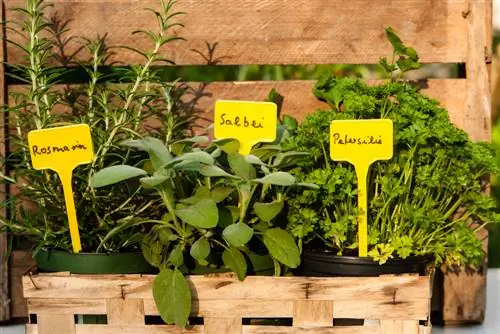
Rosemary needs a lot of sun
The tiered structure of a herb staircase offers plenty of scope for plant arrangements. In a sunny location, the herbs receive enough light on each floor for he althy growth. Nevertheless, the plants in the upper area enjoy a higher quantum of sunlight than herbs near the ground. The classic garden herb spiral acts as a model for the optimal planting plan for your new herb staircase as a simulation of the four most important climate zones of our planet. As the following table shows, the upper level should be reserved for Mediterranean sun worshipers. Native and shade-tolerant herbs gather on the middle and lower floors:
| Herbs lower floor | botanical name | Herbs middle floor | botanical name | Herbs upper floor | botanical name |
|---|---|---|---|---|---|
| Dill | Anethum graveolens | Basil ‘Provence’ | Ocimum basilicum | Thyme ‘Compactus’ | Thymus vulgaris |
| Chives ‘Profusion’ | Allium schoenoprasum | Strawberry Mint | Mentha species | Sage 'Nana' | Salvia officinalis |
| Tarragon | Artemisia dracunculus | Marjoram ‘Aureum’ | Origanum vulgare | Mountain Savory | Satureja montana |
| French sorrel | Rumex acetosa | Nasturtium, low | Tropaeolum minus | Rosemary | Rosmarinus officinalis |
| Chervil | Anthriscus cerefolium | Vietnamese coriander | Polygonum odoratum | Oregano | Origanum vulgare |
The solar yield at the location is an important premise, but not the only criterion for arranging the herb plants. Vigor and extension should also be factored into the final placement. Majestic herb species ruthlessly overshadow their plant neighbors and trigger growth depression. A place on the herb staircase is not recommended for expansive lovage or meter-high lemon balm.
Tip
Magnificent herbs are the most beautiful decoration on a herb staircase. He althy, vital growth of your potted herbs primarily depends on the right combination of sunny location, loose, permeable substrate and economical water supply. Drainage made of pottery shards prevents fatal waterlogging. Please use peat-free, organic soil, enriched with a third of lava granules for perfect water storage. Only water the herbal treasures when the substrate surface has noticeably dried.
Stone herb staircase - building instructions for the garden
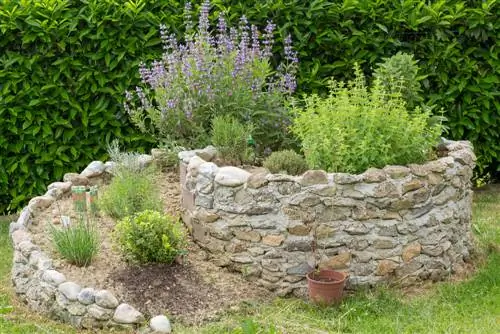
Herb spirals made of stone are a particularly durable variant of the herb staircase
You can build a herb staircase for eternity out of stones. To ensure that valuable space is not lost as cultivation area, we recommend using planting stones. Semicircular plant rings made of concrete in decorative colors are beautiful and inexpensive. With a height of 20 centimeters and a width of 34 centimeters, each stone weighs around 20 kilograms. A herb staircase made of a total of 22 plant stones and rings does not weigh more than 500 kilograms. Even a simple foundation made of gravel can support the load in the garden soil. How to build a stone herb staircase yourself:
Material and tools
- 18 pieces of plant stones
- 4 pieces of plant rings
- Gravel and gravel
- Wooden pegs, string
- Spade, folding rule, spirit level, rubber mallet, rented vibrating plate
Instructions
First measure the base area, which you mark with wooden stakes and string. Now dig the soil 30 deep and distribute the gravel as drainage and foundation. Use a rented vibrating plate to tamp down the gravel. As the bottom step, place 10 plant stones in 2 rows. Three planting stones are positioned crosswise on the back row of stones. Place 4 plant rings in front of it. 5 plant stones act as the third level. With this arrangement, a total of 14 mini beds are created within the herb staircase, which you fill with loose potting soil to grow your favorite herbs. The remaining cavities are filled with gravel, gravel, sand or garden soil during construction.
Frequently asked questions
On the lawn of my front garden I would like to build an eye-catching 1.50 meter high herb staircase made of stone myself, with pots and pots on the steps all around. What is the best way to approach this project?
A stone, head-high herb staircase cannot function without a stable foundation. Dig a 50 centimeter deep pit at the site, fill it with gravel to a height of around 35 centimeters and tamp it firmly. This is followed by an approximately 15 centimeter thick concrete slab, ideally reinforced with structural steel. After drying, build the steps in the form of square stone boxes. Fill each stone box with chippings up to about 10 centimeters below the top edge of the side walls. Lay 10 centimeter thick natural stones, field stones or bricks in the gravel bed, grouted with jointing sand. By making the long sides 30 centimeters shorter than the previous step, you create a stone herb staircase.
I want to buy a herb staircase for a balcony that is not protected from rain. Which material is best suited for the purpose?
Weather resistance is an important property for the best material for an outdoor herb staircase. In this respect, metal is clearly ahead if there is no reliable rain protection. Whether forged, cast or welded; A metal herb staircase bravely stands up to any weather. The best impregnation does not prevent a wooden herb ladder from weathering sooner or later. A longer service life can be expected if you choose a construction made of WPC wood. This is a composite material made of wood, plastic and various additives.
When is the best time to make a herb staircase for the balcony yourself?
Spring is the best time to build and plant an outdoor herb staircase. During the months of March and April you can devote yourself to the construction work at your leisure until the planting season begins at the beginning of May. Ideally, you should use February to grow your herbal favorites from seeds. Growing on the windowsill is easy on the wallet and is rewarded with vital herbs that can't hold a candle to their juiceless and weak counterparts from the supermarket.
Tip
The herb staircase on the balcony and terrace is not condemned to floral desolation in winter. While frost-sensitive herb plants stay in their winter quarters, hardy balcony plants like to take up space on the stair construction. Winter heather (Erica carnea), purple bells (Heuchera) and red carpet berries (Gaultheria procumbens) are recommended. Not to forget the secret winter queen Christmas rose (Helleborus niger), which puts on its flower dress in the middle of the cold season.

